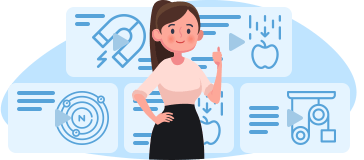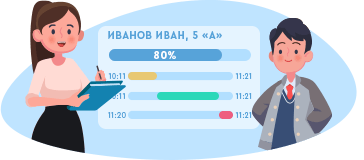— Hello, friends! My name is Martin Green. My friend’s name is James Wilson.
— Welcome to our grammar lesson!
— Listen to the dialogue between Jacob and his grandparents and you’ll find out what we are going to do today.
— Hello, granny! Hello, grandad! I’m home!
— Oh, hi, darling! How was your day at school?
— It was great, except my English lesson. Mrs. Ring wrote down the note into my record book.
— Why did she do this?
— She did it, because I didn’t behave well! She was telling us about Past Simple and Past Continuous Tenses all the lesson. I think that there is no need to talk about these two tenses for such a long time. They are the same. They describe the actions in the past, but Mrs. Ring was talking about them during the entire lesson. So, I got bored.
— Did you hear what she was trying to tell you about these two tenses?
— No, of course, not!
— Oh, Jack, you’re wrong in this situation. These tenses aren’t the same. Let us explain you the rule, but now listen very attentively.
— Okay, grandpa. You intrigued me! Now I would like to know about the difference between these two tenses.
Now you know that in the lesson today we will:
• talk about Past Simple and Past Continuous Tenses;
• learn how to use them in practice.
— Well, Jack, let’s start! First of all, granny and I will tell you when we can use Past Simple and Past Continuous Tenses. Let’s begin with Past Simple Tense.
One
We use Past Simple when we want to describe actions, which happened in the past. They are completed. The actions are not connected to the present.
For example: Cody and his sisters decorated the New Year’s tree yesterday.
Two
Past Simple is also used when we want to describe repeated actions or someone’s old habits in the past. In these sentences we can use the following words: always, often, sometimes.
For example: Alexander always bought chocolates at the weekends.
Three
We use this tense when we want to tell some story or describe the events, which went one after another in the past.
For example: Elizabeth visited her granny, helped her about the house and then the girl went home.
Four
Past Simple Tense is used to tell the details of some story or event, which happened in our life. We describe the news itself in Present Perfect, but the details in Past Simple.
For example: Billy has hurt his knee. The man fell off a ladder when he was trying to repair the roof of his house.
Five
We use this tense in the subordinate clause of time after the conjunctions: after, before, when, until, as soon as. In such sentences Past Simple Tense describes the completed actions in the past.
For example: Daniel was surprised when I told him about my wife’s illness.
Six
This tense is also used to form conditional sentences type II after the conjunction if. The second type describes unreal conditions. The situation in such sentences is related to the present or future.
For example: If Sophia had enough clothes, she would wear something beautiful to the party.
Seven
We use Past Simple in the sentences after “I wish”. Such sentences are used to express regret.
We use the construction “I wish” when we want to say that things aren’t quite going the way we want them to.
For example: I wish that my mom lived near the ocean.
Now I know when we can use Past Simple. Tell me, please, when we can use Past Continuous.
One
We use this tense to describe things that were happening at a certain moment in the past.
In such sentences we can define at a particular time. In this case we can use the following expressions: at noon, at midnight, at night, this morning at 9:45 and so on.
For example: At night Molly was washing the dishes.
We can also define at a period of time. In this case we can use the following expressions: all day, last night, this afternoon, yesterday morning, during some time, this time last month/year etc.
For example: This time last month Alice was living in Halifax.
Two
Past Continuous is used to describe a temporary situation in the past, which lasted for some period of time. We specify this period in the sentence.
For example: My parents were living in Japan for two years.
Three
We can also use Past Continuous to describe two actions that were happening at the same time in the past. In these sentences we use the following conjunctions: and, while.
For example: Madison was writing an e-mail to her best friend Lily while her sister was ironing the clothes.
Four
Past Continuous Tense is used in the sentences with Past Simple Tense. In this case Past Continuous Tense describes lasting actions and Past Simple Tense describes single actions. In such sentences single actions interrupt lasting actions.
To connect these two actions, we can use the following conjunctions: when, as, just as, before, after, while, until.
For example: William was watching the movie when his parents knocked at the door.
Five
We often use this tense when we want to tell some stories. Past Continuous is used to describe an atmosphere and environment of the stories.
For example: Zoey was driving to her parents’ house in Boston. It was sunny. She was driving very fast, because the girl really wanted to see her mom and dad.
Six
Past Continuous is also used to talk about old habits, which irritated some people. In such sentences we use the following adverbs: always, often, constantly.
For example: Addison was always biting her nails.
Seven
We use this tense when we want to describe the events, which were planned, but didn’t happen. In such sentences we can use the verbs: to mean to, to hope to, to think, to expect to, to intend to, to plan.
For example: Ryan was hopping to buy a new house, but then he was fired from his job.
Now you know, when you can use Past Continuous Tense, but you must remember that we cannot use Past Continuous with the words that are related to:
Senses
For example: To touch, To taste, To smell, To feel, To look.
Mental states
For example: To forget, To realize, To be aware, To suppose, To imagine.
Emotions
For example: To love, To hate, To like, To dislike, To fear.
Desires
For example: To wish, To prefer, To want, To mind, To plan.
Measurements
For example: To size, To contain, To include, To measure, To scale.
Opinion
For example: To think, To suppose, To guess, To expect, To assume.
and Other
such as: To be, To seem, To have (when it means to possess), To look (when it means to resemble)
— Now, Jack, we will tell you how to form these two tenses. Let’s start with Past Simple Tense.
To form positive sentences, we put the subject in first place, then we put the verb with the ending -ed if the verb is regular, for example, watched, played, jumped.
or we use the second form of the verb if it is irregular.

— Jack, what does it mean “the second form of the verb”? Do you know?
— No, I don’t, grandpa.
— All right! I’ll tell you. We have a table of irregular verbs. Let’s take a look at a small piece of this table.
— When we say the second form of the verb, it means that we need to find the verb in the table and look at this form in the second column.
— Do you understand now the meaning of the expression “the second form of the verb”?
— Yes, I do!
— Let’s look at some examples of the second form of the verb.
Swam, ran, ate, drank, gave.
To form negative sentences, we put the subject in first place, then we use the auxiliary verb did plus not, the short form is didn’t and after that we put the first form of the verb. If we have regular verb with the ending -ed, we need to remove this ending. For example: didn’t watch, didn’t play, didn’t jump. And if we have irregular verb and it is written in the second form, we need to return this verb into the first form. For example: didn’t swim, didn’t run, didn’t eat, didn’t drink, didn’t give.

To form interrogative sentences or questions we put the auxiliary verb did in first place, then we put the subject and after that, we use the first form of the verb. For example:
If the verbs are regular, we will have:
Did you watch? Did we play? Did they jump?
And if the verbs are irregular, we will have:
Did he swim? Did she run? Did you eat? Did we drink? Did they give?

Let’s look at the example.
— Hi, Larry, did you go to school today?
— No, I didn’t go to school today! I went to the museum with my mom and dad. Did you go to school?
— Yes, I did! I had six lessons. Then I went home and did my homework.
In this example we used: positive, negative and interrogative sentences.
Now, Jack, we will tell you how to form the sentences in the Past Continuous Tense.
When we form positive sentences, we put the subject in first place, then we use the verb to be in the Past Simple tense. This verb has two forms in this tense: was and were. We use was with the pronouns I, he, she, it and were with you, we, they. After that we put the main verb with the –ing suffix. For example: I was playing the piano. She was reading an article. We were cleaning the room. They were watching TV.

When we form negative sentences, we put the subject in first place, then we use one of two forms of the verb to be with not: was not or were not. Their short forms are: wasn’t and weren’t. After that we put the main verb with the –ing suffix. For example: I wasn’t playing the piano. She wasn’t reading an article. We weren’t cleaning the room. They weren’t watching TV.

When we form questions, we put one of two forms of the verb to be: was or were - in first place, then we put the subject. After that we put the main verb with the –ing suffix. For example: Was I playing the piano? Was she reading an article? Were we cleaning the room? Were they watching TV?

Look at the example.
— John, what were you doing all the evening yesterday? I couldn’t get you on the phone! Were you listening to loud music all this time?
— No, I wasn’t listening to music. I was walking with my girlfriend all the evening, because she was so upset.
In this example we used: positive, negative and interrogative sentences.
Now, Jack, tell me, please, do you know what time markers we use in these two tenses?
No, grandpa, I don’t!
Ok, let me help you with the answer.
In the Past Simple Tense, we use the following markers: yesterday, the day before yesterday, last (for example: last week, last month, last year), ago (for example: 5 days ago, 3 weeks ago).
In the Past Continuous Tense – the whole day yesterday, all the evening yesterday, still, while, when, from 4 till 6 yesterday.
— Grandpa, now I understood everything. We use these two tenses in different cases, form them in different ways. And we also use different time markers for them. You were right! Next time I will listen to my teacher very attentively and won’t misbehave. Thank you so much!
— You’re welcome, Jack!
— Now Jack knows the difference between Past Simple and Past Continuous. We hope you liked the lesson.
— See you soon, our dear friends!

 Получите свидетельство
Получите свидетельство Вход
Вход





 1090
1090

